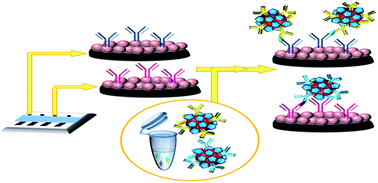Nanomaterials and biomaterials in electrochemical arrays for protein detection
Abstract
Nanomaterials and biomaterials are important components of new electrochemical arrays designed for sensitive detection of proteins in biological fluids. Such multiplexed protein arrays are predicted to have an important future in personalized medical diagnostics, especially for cancer and heart disease. Sandwich immunoassays for proteins benefit greatly in sensitivity from the use of nanostructured sensor surfaces and multilabeled detection strategies involving nano- or microparticles. In these assays, capture agents such as antibodies or aptamers are attached to sensor surfaces in the array. Target proteins with large binding constants for the affinity agents are captured from liquid samples with high efficiency, either on the sensors or on magnetic bioconjugate particles decorated with many copies of labels and antibodies. After target proteins are captured on the sensor surfaces, the labels are detected by electrochemical techniques. This feature article begins with an overview of the recent history of nanoparticles in electrochemical protein sensors, then moves on to specific examples from our own laboratories. We discuss fabrication of nanostructured sensors and arrays with the aim of multiplexed detection as well as reusability. Following this, we describe systems that integrate particle-based protein sensing with microfluidics for multiplexed protein detection. We end with predictions on the diagnostic future of protein detection.


 Please wait while we load your content...
Please wait while we load your content...